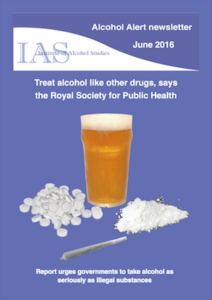In this month’s alert
Editorial – June 2016
Welcome to the June 2016 edition of Alcohol Alert, the Institute of Alcohol Studies newsletter, covering the latest updates on UK alcohol policy matters.
In this month’s issue, the Royal Society for Public Health calls for alcohol to be taken as seriously as other drugs, and health experts condemn Formula One’s sponsorship deal with Heineken. Other articles include: Breast cancer risk rises even with light alcohol use, Studies show that wine drinkers underestimate their consumption levels and that larger glasses lead people to drink more, and Blackpool Council plans a ban on alcohol adverts by 2018.
Please click on the article titles to read them. We hope you enjoy this edition.
Treat alcohol like other drugs, says the Royal Society for Public Health
The definition of drugs includes socially-embedded legal substances, such as alcohol… a comprehensive strategy “must reflect this reality”
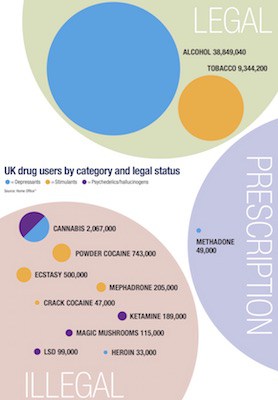 A new report from the Royal Society for Public Health (RSPH) urges the government to take alcohol as seriously as it does illegal substances. Supported by the Faculty of Public Health (FPH), ‘Taking a new line on drugs’ recommends that we should “recalibrate our understanding” of psychoactive drugs to reflect the reality that alcohol is more harmful to society than Class A drugs.
A new report from the Royal Society for Public Health (RSPH) urges the government to take alcohol as seriously as it does illegal substances. Supported by the Faculty of Public Health (FPH), ‘Taking a new line on drugs’ recommends that we should “recalibrate our understanding” of psychoactive drugs to reflect the reality that alcohol is more harmful to society than Class A drugs.
This would be best achieved by aligning alcohol, tobacco and illegal drugs strategies under the Department of Health’s lead – with ring-fenced funding transferred accordingly.
At £21bn and £13.9bn per year respectively, alcohol and smoking alone “cost society more than twice the £15.4bn associated with all Class A drugs combined, and our policy priorities should reflect this”, the report’s authors wrote.
Alcohol: More lethal than all illegal drugs
The report offers several stark facts about alcohol’s influence on users’ lives compared with illegal drugs, which are perceived to be more dangerous, despite “overwhelming evidence to the contrary.
For instance, there are more than 38 million drinkers in the UK, which according to Home Office figures is almost three times the number of users of tobacco, prescription drugs and illegal drugs combined (pictured). Naturally, as the most widely available of all drugs, alcohol causes far greater harm to health and wellbeing than many of its illegal counterparts at both individual and population level, being second only to tobacco in causing the most deaths among people in the UK.
And the report indicates that alcohol harms are worsening. The proportion of people dying from a range of alcohol-related causes remains significantly greater than it was 20 years ago for the UK as a whole, with a 19% rise in alcohol-related deaths in England from 2001 to 2012.
Alcohol causes greatest harm to others
Furthermore, while heroin, crack cocaine and methamphetamine were identified as causing the greatest harm to users, alcohol was found to cause the greatest harm to others “by a wide margin”: More than half of all violent crime in 2015 was alcohol-related; 1-in-6 road traffic deaths involves at least one driver over the legal alcohol limit; and diagnosed cases of foetal alcohol syndrome tripled in England over the past 16 years.
Streamlining strategies
The RSPH report offers 5 key pillars of a health-led – rather than crime-led – approach to drugs strategy, and aligning it to alcohol and tobacco strategies tops the list. This would involve the transfer of lead responsibility for UK illegal drugs strategy to the Department of Health.
Wales has already adopted this approach, going so far as to adopt a united substance misuse strategy encompassing both alcohol and illegal drugs. Since doing so, Wales has seen deaths from drug misuse decrease by 30%, and alcohol consumption has fallen on all three measures: drinking above guidelines, heavy (binge) drinking, and very heavy drinking.
You can listen to RSPH chief executive Shirley Cramer CBE discuss the report in our Alcohol Alert podcast:
Formula One puts Heineken in the driving seat
Multi-million dollar partnership with beer giant glorifies car-racing’s relationship with alcohol brands
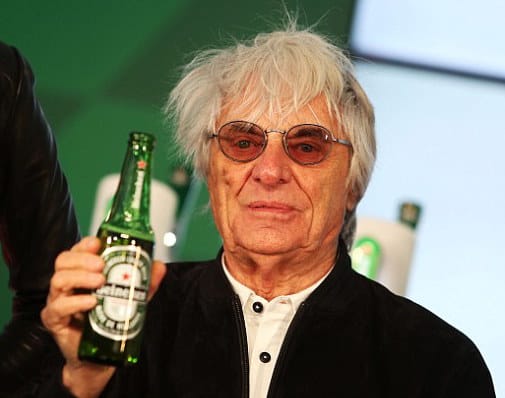 40 NGOs have written to Fédération Internationale de l’Automobile (FIA) president Jean Todt calling for an end to alcohol sponsorship in Formula One (F1), following the announcement of a new 5-year deal between the racing sport and Heineken estimated to be worth $150 m.
40 NGOs have written to Fédération Internationale de l’Automobile (FIA) president Jean Todt calling for an end to alcohol sponsorship in Formula One (F1), following the announcement of a new 5-year deal between the racing sport and Heineken estimated to be worth $150 m.
The agreement – the largest by a drinks manufacturer in motor racing history – makes the alcohol brand one of the sport’s main sponsors, with exposure across trackside billboards, its name displayed at all events, and other promotional activities.
But health experts condemned the move, led by the European Alcohol Health Alliance (Eurocare). Secretary general Mariann Skar said “F1 should ask themselves if they want to be a motor sport or an alcohol brand event”, and professor Frank Murray, Alcohol Health Alliance Ireland chair, described the deal as “truly shocking”, asking “surely Heineken has a responsibility to break the link between drinking and driving?”
F1 advertising: Driving you to drink?
Heineken celebrated the partnership following the 2016 Canadian Grand Prix with an event showcasing former racers David Coulthard and Jackie Stewart as brand ambassadors. The Amsterdam-based brewer also pledged its commitment to an anti- drink-driving campaign – ‘If You Drive, Never Drink’ – set for “TV, digital, live fan experiences and events, PR initiatives, and point-of-sale activations.”
Speaking at the launch, F1 chief executive Bernie Ecclestone (pictured) remarked that he believed the scheme reflected Heineken’s strong values.
He said: “Some time ago I started a ‘Think Before You Drive’ campaign at F1 Events. I am pleased that this important initiative now has such strong and committed support from Heineken, through its “If You Drive, Never Drink” campaign. We will now evolve and reinforce these messages in a way that reflects the Heineken personality and values.”
F1 teams were reported to have backed Heineken amid the controversy surrounding the pact. Manor’s Dave Ryan said: “I think it (Heineken) will be great for Formula 1 so no, I don’t have a problem with that level of involvement.” Red Bull, Christian Horner of agreed, adding “There are some great brands involved in Formula 1 now… I think it’s a positive thing.”
But alcohol brands’ dominance of F1 continues to link driving to drinking, which in excess can be a significant cause of avoidable physical, mental and social harm. Commenting on the deal, Mariann Skar, secretary general of Eurocare, raised the question of this association. She said: “F1 should ask themselves if they want to be a motor sport or an alcohol brand event?
“When monitoring F1 in Monaco Grand Prix 2015, we found 11 references to alcohol brands per minute, averaging one reference every 5 seconds. How will it be when Heineken comes in as main sponsor in addition to the others?
“If both the sport and the drinks producers want to be seen as responsible industries, they should stop this deal and move away from alcohol sponsorship in F1.”
Think Heineken before driving?
Drink-driving is one of the key killers on the road. The United Nations’ new Sustainable Development Goals aims to halve the number of global deaths and injuries from road traffic accidents in their target 3.6. The principle not to link alcohol brands and driving are clearly established in both the EU regulation for advertising (Audio-Visual Media Services Directive) and in the drinks industry’s own codes. “It is surprising that both F1 management and Heineken chose to interpret their sponsorship practice as something other than advertising”, said Skar.
She added: “(Bernie Ecclestone) should know that drink-driving is one of the key killers. It surprises me he wants a slogan along the lines of “think Heineken before driving” being introduced under his leadership.”
Eurocare has called for stronger legislation, both from the European Commission and from individual Member States, to follow France’s example of banning alcohol sponsorship of sport events.
Minimum pricing court battle returns home
Evidence has been aired and the judges’ verdict is to be given in due course, but the case may still be settled at the UK Supreme Court
Judges at Scotland’s highest civil court listened to a fresh set of legal arguments for and against the Scottish government’s plans to introduce a minimum unit price for alcohol.
In the latest round of the long-running case, the court heard that new figures on consumption trends, alcohol-related illness and death rates had indicated a “flattening out” of downward trends in those categories.
Judges were told that ministers feared that it could mark the start of a longer-term trend, while the opposition accused lawyers representing the Scottish government of rehashing submissions already made.
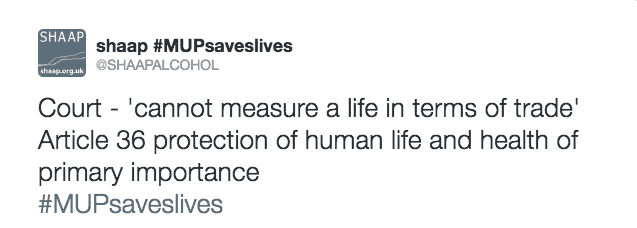 Proceedings
Proceedings
Gerry Moynihan QC, for Scottish ministers, told the court the proceedings were “unique”. Over the 2-day period, he urged the Lord President Lord Carloway, sitting with Lords Menzies and Brodie, to consider fresh figures on drink consumption, morbidity and mortality, emphasised that the statistics previously put before the court stemmed from 2012 – when the legislation was first passed – were now “out of date”.
Mr Moynihan argued the recession had an impact on people’s drinking habits but spending began to rise when that ended “with an impact again on mortality”. He argued that by 2014, data pointed to an “upturn” in mortality rates.
Aidan O’Neill QC, for the Scotch Whisky Association (SWA), said the other side was “rehashing” submissions already made and argued they were not addressing the points raised by the European Court of Justice (ECJ), which concluded that a tax rise on alcohol “is liable to be less restrictive of trade” than minimum pricing.
However, the court also heard from the team representing the Scottish ministers that the ECJ described a required increase in excise duty to minimum unit price level to be “unrealistic”, “disproportionate”, and self-evidently “distortive of trade”. Minimum unit pricing was acknowledged to have a defence under Article 36 of the Treaty of the European Union, if deemed necessary to protect human life and health, as SHAAP tweeted (pictured).
The (pen)ultimate judgment
The points were made at the Court of Session in Edinburgh to the judges as they consider an earlier opinion from the ECJ over the legal challenge brought by the SWA.
MSPs backed the move 4 years ago but the measure has not yet been introduced because the SWA and other European wine and spirits producers took legal action, arguing the move would breach European law, and damage an export industry worth more than £4bn to the Scottish economy every year.
Scottish judge Lord Doherty initially rejected the challenge in 2013, but it was later referred to the ECJ after an appeal hearing. The ECJ gave its verdict on Scotland’s minimum unit pricing case on 23 December 2015, echoing the preceding opinion of Yves Bot, the Advocate General. His statement concluded that MUP does not contravene European law, provided it meets the objective of protecting public health.
The ECJ also stated that it will be for the Scottish Inner House of the Court of Session to rule on MUP, but that it can only decide in favour of the measure if ‘proportionality’ can be proved, and crucially that the aims of minimum unit pricing cannot be better achieved by taxation rises.
After examining all of the evidence – including the opinion of the European Court of Justice – the three judges will decide whether improvements in public health could be achieved by other means, such as increasing tax rates on alcohol, rather than minimum pricing.
They will deliver their findings at a later date – but even that is unlikely to be the end of the saga, with an appeal against the ruling likely from either side to take the issue to the UK Supreme Court.
Blog: It’s time to stop work, it’s time to drink beers
The exclusive presence of the Carlsberg brand during this year’s Euro 2016 football tournament provides a “perfect opportunity” to compare alcohol marketing in France with that of the UK, writes Dr Richard Purves
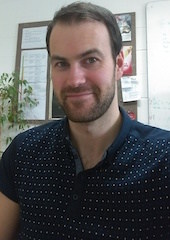 “People of England, lend me your ears. It’s time to stop work, it’s time to drink beers.” Thus sounds the rallying call to a nation of football fans. This call to arms is part of Carlsberg’s latest advertising campaign designed to cement the association between consuming alcohol and supporting your national team. Carlsberg is the ‘official beer’ of the UEFA Euro Championship and the England Football team and this year’s Euro Championship in France promises to be the biggest ever with 24 teams playing 51 matches (instead of the usual 16 teams). This means it will also be the biggest ever in terms of sponsorship rights. UEFA expects to generate between €450 and €500 million in sponsorship revenue, an increase in more than 50% from the EURO 2012 tournament.
“People of England, lend me your ears. It’s time to stop work, it’s time to drink beers.” Thus sounds the rallying call to a nation of football fans. This call to arms is part of Carlsberg’s latest advertising campaign designed to cement the association between consuming alcohol and supporting your national team. Carlsberg is the ‘official beer’ of the UEFA Euro Championship and the England Football team and this year’s Euro Championship in France promises to be the biggest ever with 24 teams playing 51 matches (instead of the usual 16 teams). This means it will also be the biggest ever in terms of sponsorship rights. UEFA expects to generate between €450 and €500 million in sponsorship revenue, an increase in more than 50% from the EURO 2012 tournament.
Carlsberg’s latest advertising campaign will run in the lead up and throughout the tournament. Supporters are encouraged to “pack the pubs” because “games aren’t just won on the pitch, they’re won in the pub.” However, it would appear that the real winners could be the pubs themselves as Carlsberg UK states that football tournaments are worth more than £60 million to the on-trade and claim that showing live football matches can add 60% to an outlet’s rate of sale. With this in mind, Carlsberg is investing heavily in the on-trade by providing 10,000 point of sale kits to pubs in England, Wales and Scotland consisting of fixture posters, planners, flags and wigs. The company has already begun rebranding 19 pub across England as ‘The Three Lions’, substituting the pubs’ previous signage with branded fascia and signs featuring England footballers such as Wayne Rooney and Jamie Vardy. The selected pubs will also be provided with exclusive branded glassware featuring the three lions crest to deliver “an incredible experience” for consumers.
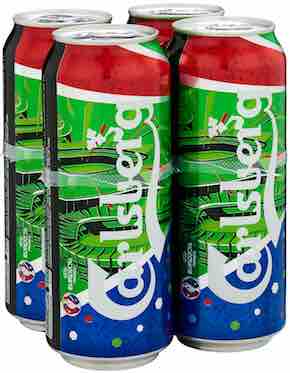 For those fans who prefer to watch their football at home, Carlsberg has created limited-edition packaging which features a mix of the brand’s traditional green colour with the French colours of red, white and blue alongside images of stadiums, supporters and footballs (example illustrated). Packaging for Carlsberg Export features a silver football boot where the studs have been replaced by French landmarks such as the Eiffel Tower and the Arc de Triomphe. Both products offer the chance to win an all-expenses paid trip to Paris and the opportunity to present the ‘Carlsberg Man of the Match’ trophy at an England group game. Armchair fans are also offered the chance to vote for the man of the match through Carlsberg’s social media platforms. Recent statistics from NHS Scotland show that levels of alcohol consumption in Scotland have risen and this has been attributed to the growth in off-trade sales. Even though the Scottish national team did not qualify for the EURO finals, this has not prevented alcohol brands such as Carlsberg and Heineken from filling the supermarket shelves across the UK with limited edition packs. Alcohol continues to be promoted as the essential accompaniment to watching the football. With some supermarkets offering 20 cans of Carlsberg (440ml) for as little as £10 throughout the tournament there is every chance that this upward trend will continue.
For those fans who prefer to watch their football at home, Carlsberg has created limited-edition packaging which features a mix of the brand’s traditional green colour with the French colours of red, white and blue alongside images of stadiums, supporters and footballs (example illustrated). Packaging for Carlsberg Export features a silver football boot where the studs have been replaced by French landmarks such as the Eiffel Tower and the Arc de Triomphe. Both products offer the chance to win an all-expenses paid trip to Paris and the opportunity to present the ‘Carlsberg Man of the Match’ trophy at an England group game. Armchair fans are also offered the chance to vote for the man of the match through Carlsberg’s social media platforms. Recent statistics from NHS Scotland show that levels of alcohol consumption in Scotland have risen and this has been attributed to the growth in off-trade sales. Even though the Scottish national team did not qualify for the EURO finals, this has not prevented alcohol brands such as Carlsberg and Heineken from filling the supermarket shelves across the UK with limited edition packs. Alcohol continues to be promoted as the essential accompaniment to watching the football. With some supermarkets offering 20 cans of Carlsberg (440ml) for as little as £10 throughout the tournament there is every chance that this upward trend will continue.
Carlsberg has sponsored the UEFA Euro finals since 1988 and has been associated with the England national side for over 20 years. Sponsorship of the 2012 tournament in Poland and Ukraine entitled the brand to: have its logo on pitch side electronic sponsor boards and many other areas; have exclusive marketing rights for alcoholic beverages within stadia and ‘fan zones’ (outdoor areas where fans without match tickets could congregate to watch live matches on giant screens); and use EURO 2012 logos on its products. The 2012 tournament was reportedly worth £609 million to Carlsberg which explains why it devotes around a third of its marketing budget to sponsoring the Euros. Even though Carlsberg reportedly paid $75 million for a new four-year contract beginning in 2014, Loi Evin legislation in France prohibits the advertisement of alcoholic products at sporting events. This means that this year the beer company will not have perimeter board advertising, or broadcast sponsorship in the tournament’s host market. However, trade industry press reports that “TV idents will be shown during matches broadcast on ITV including the tournament’s semi-finals and final, while perimeter LED advertising boards will highlight the lager brand at every match”. This could mean that digital technology may be used to insert virtual advertising images into a live broadcast to replace the pitch-side advertising which is subject to Loi Evin regulations. This practice has been in place for several years and has previously been used during England friendly matches played in Switzerland and the Netherlands. This allows for more targeted advertising to be seen by viewers from other countries. A deal has also been struck to serve Kronenbourg’s new non-alcoholic ‘Tourtel Twist’ brand at the stadiums. Kronenbourg is owned by Carlsberg and the alcoholic version of Kronenbourg will also be sold at the official fan zones, giving the brand an exclusive presence at the tournament.
This year’s tournament therefore provides a perfect opportunity to conduct a natural experiment, comparing the amount of advertising and sponsorship in matches broadcast in France (with restrictions on broadcast and pitch-side) with the amount in matches broadcast in the UK (where the pitch-side restrictions will apply because the matches are played in France, but not the broadcast restrictions). The Institute for Social Marketing has secured funding from the Institute of Alcohol Studies and Scottish Health Action on Alcohol Problems (SHAAP) to conduct a frequency analysis of visual and verbal references to alcohol on a sample of Euro 2016 matches broadcast on UK, French and Irish television. In this way, we will be able to assess first of all how the Loi Evin reduces UK and Irish citizens’ exposure to alcohol references, and secondly, what further reduction in UK and Irish citizens’ exposure could be obtained if the Loi Evin was implemented in these countries.
Originally written for IAS Blogs.
Breast cancer risk rises even with light alcohol use
Strong dose-response relationship detected in meta-analysis
A new study concludes that all levels of alcohol use – even light drinking – are associated with raised risk for breast cancer, with higher consumption linked to higher risk. The research, led Dr. Kevin D. Shield from the International Agency for Research on Cancer (IARC), was a three-part study that involved: 1) a summary review of the existing literature on the relationship between alcohol use and breast cancer; 2) an examination of the data from already published meta-analyses of the risk relationship between both factors, focusing on light drinking; and 3) an assessment of the global impact of such a link.
The researchers’ data came from Global Information System on Alcohol and Health (GISAH), and the data on cancer mortality came from the GLOBOCAN database. They used a method called Population-Attributable (PAF) methodology to produce the estimates from these data sets – PAF calculates the number of cases or deaths that would not occur if the risk factor were reduced to an alternative scenario (for example, no alcohol use).
All but two of the 15 meta-analyses that met the researchers’ criteria showed a dose-response relationship between alcohol consumption and the risk of breast cancer – even at low levels of consumption. Thus, even light alcohol drinkers are at higher risk for breast cancer than non-drinkers, they found.
Furthermore, when they assessed the impact of these findings on the global burden of breast cancer, the team estimated that 144,000 breast cancer cases and 38,000 breast cancer deaths in 2012 were caused by alcohol use. Moreover, in 18.8% of the cases and 17.5% of the deaths, the women were light drinkers.
These findings address a long-standing debate about whether light alcohol consumption is linked to raised risk of breast cancer.
The link between alcohol consumption and cancer was officially declared in 1987, when a working group of the IARC – an agency of the World Health Organization (WHO) – listed cancers of the oral cavity, pharynx, larynx, oesophagus, and liver as “causally related to the consumption of alcoholic beverages.” Since then, many studies have found links between alcohol consumption and breast cancer, and another review in 2007 added breast cancer and colorectal cancer to the former list of cancers.
The authors also note that as recently as 2014, studies have revealed convincing evidence that alcohol raises the risk of breast cancer. However, relatively few studies have focused specifically on the question of whether light drinking is linked to breast cancer.
Dr. Shield and his colleagues said:
“All levels of evidence showed a risk relationship between alcohol consumption and the risk of breast cancer, even at low levels of consumption. Due to this strong relationship, and to the amount of alcohol consumed globally, the incidence of and mortality from alcohol-attributable breast cancer is large.”
‘Alcohol use and breast cancer: A critical review‘, is published in the journal Alcoholism: Clinical and Experimental Research.
True alcohol content of wine underestimated
Many more heavy drinkers than previous studies have suggested
University College London researchers at the department of Epidemiology and Public Health have found that estimates of wine consumption have failed to adjust for changes in serving sizes and the alcohol content of wine consumed. The misclassification of alcohol intake has knock-on effects both for studies calculating the proportion of the population who drink above the low-risk drinking guidelines, and for identifying the health risks associated with different levels of consumption.
Data were drawn from the self-reported results of Phase 5 of the Whitehall II study of British civil servants (1997–1999), involving 7,010 participants aged 47 to 67 years. They were the first cohort to experience the shift in standardised serving wine glass serving sizes from 125ml to 175ml. The research team also adopted a conversion factor of 8g alcohol per wine glass (1 unit) was compared with a conversion of 16g per wine glass (2 units), a reflection of the modal ABV of wine at the time being 11.5% (11.5% x 175ml = 2 units).
When applying the higher alcohol content conversion for wine consumption, the proportion of heavy / very heavy drinkers increased from 28% to 41% for men and 15% to 28% for women. There was a significantly increased risk of very heavy drinking compared with moderate drinking as a cause of death. However, the mortality risk (hazard ratios) was lower for all causes post-conversion. This may be in part explained by the increase in the proportion of wine drinkers of higher socio-economic status who qualified for the higher consumption bracket post-conversion.
The team’s findings may have underreported consumption of alcoholic beverages purchased off-trade due to the likelihood of drinkers pouring themselves even larger servings than on-trade standard sizes. Therefore, they argued, more detailed information on the purchases of alcohol made is required.
Writing in the journal Alcohol and Alcoholism, they concluded: “The alcohol content in a wine glass is likely to be underestimated in population surveys as wine strength and serving size have increased in recent years. Investigator-led cohorts need to revisit conversion factors based on more accurate estimates of alcohol content in wine glasses.”
Nalmefene less effective than first thought
Clinical trials for drug called into question
New research from Stirling University has found that there was “insufficient evidence” to prove the effectiveness of a newly licensed drug used to treat alcohol dependence.
Nalmefene, which was approved (as Selincro) in continental Europe in February 2013, was subsequently recommended by the UK National Institute for Health and Care Excellence (NICE).
But a team of scientists has found problems with the way clinical trials were conducted and analysed, making it impossible to know how much the drug actually helps to reduce drinking in patients dependent on alcohol.
The group of experts analysed the published studies of Nalmefene that formed the basis for the licensing and NICE decision.
Writing in the journal Addiction, they concluded evidence of its effectiveness was weak and any possible effect on patients was small at around a one drink per day reduction on average.
In the trials, side-effects were generally more common in patients taking Nalmefene, who were also more likely to drop out of the trials.
The research also found Nalmefene is more expensive than similar drugs on the market and that no comparison with these alternatives was made.
Dr Niamh Fitzgerald, a pharmacist and lecturer in alcohol studies at the university’s Institute for Social Marketing, led the study.
She said: “It’s vitally important that we know that prescribed drugs are effective in treating the intended problem.
“In this case, we found problems with the registration, design, analysis and reporting of these clinical trials which did not prevent the drug being licensed or recommended for use.
“We believe this creates a difficulty for doctors trying to treat alcohol dependence and throws up critical questions for regulators around why a drug was licensed without a bank of high quality, reliable evidence.”
Drink-driving’s unacceptability declines
THINK! survey harbours worrying slip in anti- drink-drive attitudes
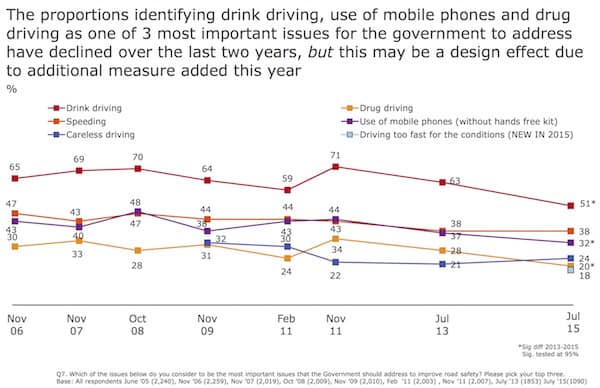 The biennial survey by the Department for Transport’s road safety website, THINK!, has revealed a decrease in the number of people who deem drink driving to be unacceptable, the RAC reports.
The biennial survey by the Department for Transport’s road safety website, THINK!, has revealed a decrease in the number of people who deem drink driving to be unacceptable, the RAC reports.
While drink-driving remained the top ranked issue of interest across several key indicators of safety, the proportion of respondents identifying drink-driving as the most important issue for the government to address declined from 63% in 2013 to 51% in 2015, although THINK! was quick to stress that this may have been down to a design effect due to an additional factor added to the survey questions set (illustrated).
The proportion of those questioned who agreed that driving while over the legal limit is dangerous fell 4 percentage-points on the previous survey (from 89 in 2013 to 85% in 2015), a change mainly driven by non-motorists.
There was also a reduction in the level of agreement over its acceptability compared with the 2013 survey. This was influenced by the answers of motorists aged between 17 and 34, who also admitted to being more likely to drive even if unsure they were over the legal alcohol limit.
However, THINK! noted that – more positively – fewer people now know someone who drives when over the alcohol limit or when unsure (compared with 2013 survey results).
The THINK! website states: “Our research shows that although our target audience (males aged 17–34 years) widely see drink-driving as unacceptable, they do not see their own behaviour as drink-driving. They’re vague about what the legal limit is, and how it’s measured.
“Because of this they set their own perceived safe limit, often 2 drinks. They often justify having 2 drinks, or stretching this further, due to circumstances on the night such as having drinks bought for them and whether they feel safe to drive. We want to shake our audience’s confidence in their ability to drive after a second drink.”
Larger wine glasses may lead people to drink more
Study finds bigger wine glasses led to an almost 10% increase in wine sales
Selling wine in larger wine glasses may encourage people to drink more, even when the amount of wine remains the same, suggests new research published in the journal BMC Public Health.
To examine whether the size of glass in which alcohol is served affects consumption, a research unit from the University of Cambridge (together with Professor Marcus Munafo from the University of Bristol) carried out a study in The Pint Shop in Cambridge from mid-March to early July 2015. Wine (in 125ml or 175ml servings) could be purchased by the glass, which was usually a standard 300ml size.
Over the course of a 16-week period, the owners of the establishment changed the size of the wine glasses at fortnightly intervals, alternating between the standard (300ml) size, and larger (370ml) and smaller (250 ml) glasses.
The researchers found that the volume of wine purchased daily was 9.4% higher when sold in larger glasses compared to standard-sized glasses. This effect was mainly driven by sales in the bar area, which saw an increase in sales of 14.4%, compared to an 8.2% increase in sales in the restaurant. The findings were inconclusive as to whether sales were different with smaller compared to standard-sized glasses.
“We found that increasing the size of wine glasses, even without increasing the amount of wine, leads people to drink more,” says Dr Rachel Pechey from the Behaviour and Health Research Unit at Cambridge. “It’s not obvious why this should be the case, but one reason may be that larger glasses change our perceptions of the amount of wine, leading us to drink faster and order more. But it’s interesting that we didn’t see the opposite effect when we switched to smaller wine glasses.”
Professor Theresa Marteau, director of the unit, adds: “This suggests that avoiding the use of larger wine glasses could reduce the amount that people drink. We need more research to confirm this effect, but if it is the case, then we will need to think how this might be implemented. For example, could it be an alcohol licensing requirements that all wine glasses have to be below a certain size?”
Ireland: Plan to ban drink ads changed after job losses claim
Adapted from the Irish Independent
Plans to ban billboards and hoardings advertising alcoholic beverages near schools in Ireland were watered down after advertisers warned that the proposed changes would have a devastating impact on businesses and lead to job losses.
A 250-metre exclusion zone around schools was recommended in a report by the Oireachtas Health Committee.
However, the Government opted for a 200-metre exclusion zone when it approved new alcohol advertising legislation late last year.
It has now emerged the Department of Health was lobbied on the issue by some of the country’s major outdoor advertising firms.
Documents released under the Freedom of Information Act reveal the department was warned by the Outdoor Media Association (OMA) that proposed changes would have “a devastating effect” on advertising businesses and were “bound to lead to job losses”.
The OMA represents Clear Channel Ireland, Exterion Media and JCDecaux Ireland, which together account for 90% of the country’s outdoor advertising market. In a briefing document released to the Irish Independent, the association unsuccessfully argued that the self-policed 100-metre zone currently in operation was “a sensible restriction which reflects the distance at which posters can be seen”.
It said OMA members had around 7,600 roadside panels and that if a 250-metre exclusion zone was introduced, this would mean over half of them – some 4,075 – could not be used to advertise alcoholic beverages.
The documents also reveal the then-Health Minister Leo Varadkar declined a request to meet the OMA last September, but sent officials to meet them instead.
The Public Health (Alcohol) Bill which subsequently emerged contains a 200-metre exclusion zone, which means just 2,908 advertising sites will be excluded should be legislation be enacted.
Ban on alcohol adverts in Blackpool by 2018
Council considers measure to reduce drink-related crime and health problems
Councillors will be asked to consider imposing a ban near pubs, shops and off-licences in a new Alcohol Strategy for Blackpool.
The report, to be discussed at the council’s Health and Wellbeing Board, calls on the authority to create a new by-law by March 2018, extending an alcohol advertising ban beyond council premises.
The ban was first mooted three years ago but this is the first time a timetable has been set for a possible by-law.
The latest report notes that drink-related death rates for both men and women in the resort are “significantly higher” than the national average.
Blackpool, a popular destination for stag and hen parties, also has the highest rate of alcohol-related hospital admissions of any local authority in England.
“Alcohol is too often a precursor and catalyst for crime and disorder in Blackpool in addition to creating health and safety issues,” it said.
Residents are “significantly more likely” to be victims of alcohol-related sex crimes and the rate of drink-related violent crimes is “more than double the England rate.”
Other measures to tackle alcohol abuse include “wet gardens” where street drinkers could be directed from parts of the town where they commit anti-social behaviour, and “recovery centres” where people could go to sleep off their drink-intake when the clubs close or be rehydrated with bottled water instead of ending up in A&E, police cells or having a fight.
A night-time safe haven bus already operates during summer weekends offering support to party-goers and vulnerable people in the town centre.
Businesses should share alcohol sales data
Alcohol charity boss leads calls for greater transparency
All premises selling alcohol – including both supermarkets and pubs – should be prepared to provide data to their local licensing board on how much alcohol they are selling, says Alcohol Focus Scotland.
Plans would require businesses to declare the volume of alcohol they sold, such data “would provide a much fuller picture to boards and may allow them to see the different impact of different kinds of premises (eg. a supermarket or a corner shop), and therefore to make more informed decisions”, said chief executive Alison Douglas.
Addressing the Scottish Licensing Law and Practice conference, Ms Douglas argued that it should be a condition of getting a premises licence that licence holders provide data on how much drink they actually sell. Boards in turn could be required to publish aggregate sales data for their area as part of their annual reporting. This could help inform future government alcohol policy on availability.
Ms Douglas told the conference of liquor law practitioners that current requirements for areas to have ‘over-provision policies’ were having limited effect, as 96% of licences were approved and the number of places last selling liquor had risen in each of the last four years. She was also critical of claims of commercial sensitivity for not divulging sales data, claiming the current system could be amended so information on individual businesses was kept private.
Dr Peter Rice, Scottish Health Action on Alcohol Problems chair and one of the country’s leading medical voices on the harm caused by drink, has been lobbying MSPs to improve the contribution of licensing boards towards tackling alcohol harm.
He said that “the proxy measures we have about sales such as shelf space are inadequate and we need to move beyond a headcount of premises”, and that “without sales data, licensing boards are hampered in what they can meaningfully do to protect public health.”
Stephen Dornan, who headed the Glasgow Licensing Board during the early years of the current alcohol strategy, supported the proposal, adding: “Revealing such data would be a huge benefit in painting a fuller picture of who is selling how much alcohol. But really this needs legislation to back it up if it is to withstand certain legal challenges.”
Figures unveiled last month showed around 10.8 litres of pure alcohol was sold per adult last year in Scotland – the equivalent of 41 bottles of vodka – reversing the downward trend over most of the last decade.
Alcohol Focus Scotland argues this is being driven by low cost, high strength products, with their recent price survey showing it was possible to exceed the weekly guidelines for £2.52, the price of a takeaway coffee. They say this proves the need for action to increase price and reduce availability.
Academics create app to help people Drink Less
UCL researchers call for testers looking to cut down on their alcohol consumption?
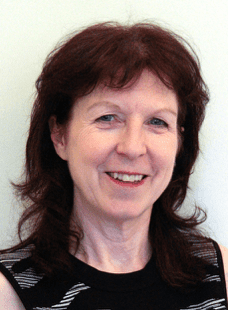
A team of psychologists at University College London (UCL) has developed a brand new app to help people who want to get healthier and save money by drinking less alcohol, but are unsure how to go about it.
The app, called Drink Less, is a free, user-friendly piece of software utilising the latest thinking about behaviour change, and its makers claim the techniques it contains are based on solid scientific evidence. The app contains a number of different features:
- A drinking tracker, to see how the user’s consumption habits change over time
- A function to set goals for the targets that are important to the user and get feedback on progress
- A daily mood diary in order for a user to better understand the effects of his / her hangover
- Games designed to strengthen the user’s resolve to drink less alcohol
- A planner for dealing with situations when a user is tempted to drink excessively
- Take part in exercises designed to change a user’s relationship with alcohol
Prof Susan Michie (pictured), a member of the app-making team, said: “Drink Less is an engaging app based on scientific evidence to help people reduce excessive alcohol consumption.” It’s also part of an experiment designed to allow researchers to understand what helps people drink less, therefore improving users’ health.
The app can be downloaded via the Apple Store (currently available for iPhones only) and you can get more information on their web site drinklessalcohol.com.
Podcast
Our monthly podcast features interviews with experts from across the sector.
Gambling industry harms and parallels with the alcohol world
Will Prochaska –
Coalition to End Gambling Ads

